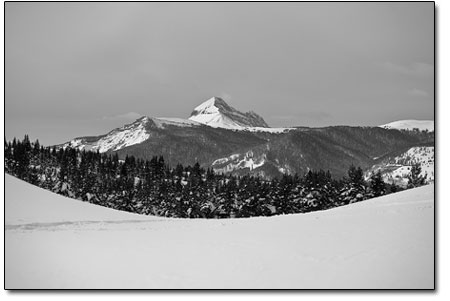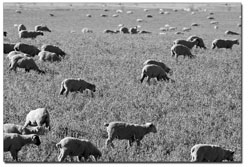|
| ||||
| Sediment study hits home
by Allen Best Jason Neff reads the muck from two ponds high in Colorado’s San Juan Mountains the way you might read a history book. Sediment shows small but steady accumulations of dust for about 5,000 years, he says in an article in the current issue of Nature Geosciences. Then, about 150 years ago, there was a 500 percent increase in the sediments. It was, he notes, a time when cattle and other livestock were being introduced onto the deserts of the Southwest in large numbers. The two, he believes, are linked. “It’s borderline impossible to explain this without humans,” says Neff, a biogeochemist at the University of Colorado at Boulder. One lake is located near Ophir Pass, and the other in Senator Beck Basin, near Red Mountain Pass. Neff is the latest to document how human activities in one area have had consequences in distant places as a result of wind deposition. In Antarctica, ice cores have revealed a surge in dust about the time that large-scale grazing began in the Patagonia area of South America. In Greenland, another ice core showed black carbon pollution peaking with the widespread burning of coal in North America and, more recently, China. The study of airborne particulates is becoming one of the hottest areas of climate change, according to Joe McConnell, a scientist at the Desert Research Institute in Reno. Scientists, he says, are still assessing how much climate change can be attributed to anthropogenic, or manmade causes, and how much to natural climate change. Neff’s work also complements that of Tom Painter, a scientist now based in Salt Lake City who released a report last summer showing dust from the Southwest is causing snowmelt runoff in the San Juans to begin eight to 32 days earlier. Icing on the cake Neff and Painter both began their projects in 2003, but for different reasons. Neff was in the San Juans studying nutrient cycling in ecosystems to determine how the composition of the underlying rocks affects what kinds of trees grow. But rocks are not the sole source of nutrients. Dust blown in from other areas always has been a part of the alpine ecology. To better understand this, Neff took samples of the mud from the lakes. The lakes, which are located at about 12,000 feet in elevation, slightly above timberline, were chosen because they showed no evidence of disturbance, as from mining or other activities. He found dust steadily accumulated in small increments over the last 5,000 years, but then there was a sudden acceleration about 150 years ago. The time sequence was determined by radiocarbon dating of twigs and other debris found in the mud. But how could he tell where the dust came from? Neff says there are two keys. Texture is one. If the particles are large, they’re not from Asia. Although dust from Asia does blow into North America, previous research has shown that larger particles, such as are found in the San Juan lakes, are not routinely carried that far. The icing on the cake, he says, are the isotopic signatures of the materials, which show they were not from surrounding bedrock. In fact, they look very much like the dust on snow documented in Painter’s research. Although the precise origin of the San Juan dust is difficult to determine, the chemical signatures overlap with the basement rocks of Arizona, New Mexico and northern Mexico. Further evidence of the regional source comes from satellite detection of dust plumes arising in the desert of the Southwest at about the same time dust has been deposited on San Juan snow. Scientists also use something called atmospheric back-trajectory modeling, meaning that they can trace wind speed and velocity recorded when dust falls on snow to figure out the probable source. The case for cattle Neff notes that the “clear and abrupt transition” in the lake core sediments was simultaneous with an intensification of land use in the West, particularly livestock grazing. Although cattle and sheep grazing had been introduced to the Southwest by 1600, says Neff, it took the arrival of railroads after the Civil War to make it a large-scale commercial activity. Within a few decades, the number of livestock being grazed had increased from a relative few to 40 million. By the early 1930s, two-thirds of the land in northeastern Arizona had been significantly disturbed by livestock use. “Overall, nearly 70 percent of the natural ecosystems of the western Untied States have been affected by livestock grazing, resulting in loss of soil stability and increases in wind erosion,” says Neff.
Deposition of lake sediments slowed again in the 20th century. Again, Neff thinks he has an explanation. Because of the extensive degradation of the rangelands, Congress in 1934 passed the Taylor Grazing Act, named after Glenwood Springs-based congressman Edward Taylor. The law established the Grazing Service – which later became the Bureau of Land Management – and established controls on grazing of public lands. Neff also found evidences of increased phosphorous, nitrogen and carbon in the lake sediments. Again, he finds it difficult to explain these spiked levels without the explanation of humans, but is less conclusive about the links. He said he hopes to expand his research, both into the Sangre de Cristo range of New Mexico and Colorado’s northern mountains. McConnell wasn’t surprised by Neff’s conclusions. “It is consistent with what we have found in the polar regions,” says McConnell, who directs the Ultra-Trace Chemistry Laboratory at the Desert Research Institute. Taking ice core samples on the North Antarctica Peninsula, McConnell found a doubling of dust that was concurrent with the introduction of sheep in Patagonia, although also concurrent with a changing climate. McConnell, in studying Greenland ice, also finds evidence of industrialization, this time with a seven-fold increase in concentrations of black carbon. The increase began about 1850, then accelerated sharply during the late 19th century before declining slowly. But the ice core study in Greenland also shows success. In the early 1970s, the Clean Air Act was implemented in the United States, with similar efforts under way in other countries. The success of that regulation, he says in a report published last year in the prestigious journal Science, is reflected in the ice, with a sharp drop, almost to pre-industrial levels, by 2002. A disturbing agent This latest report also is consistent with findings by Jayne Belnap, a research ecologist with the U.S. Geological Survey who works out of Moab. Dust will blow naturally from some deserts, she says, but not from the deserts of the Southwest. “The dust just doesn’t blow. You have to have a disturbing agent,” says Belnap, who has conducted experiments to prove this. To explain the amount of dust recorded in the San Juans, she sees only one feasible explanation: cattle. What this report also points to is the transfer of nutrients from deserts to alpine ecosystems. Adding nutrients to the high mountains favors some plants over others, she says. At the same time, the deserts lose fertility. But dust also is interesting because of its role in the changing climate. Still uncertain, however, is what that role is. Dust in the atmosphere is “going to be both heat absorbing, and it’s going to prevent heat from entering the atmosphere,” explains Belnap. “So it’s very complicated, and no one really understands the total impact.” Also still uncertain is the role of dust on snow. As documented by Painter’s study, dust decreases the amount of time that snow lingers on the ground, owing to how darker material more readily absorbs solar radiation. This, in turn, causes the ground to heat up, possibly accelerating global warming. “People are really scratching their heads, trying to figure out how to get this into the global climate models,” says Belnap. “But nobody is arguing that it doesn’t belong in there.” No pointed fingers Neff says that in studying ecosystems, often the processes are very subtle. “But when you look at these sediment cores, there’s nothing subtle about what happened 100 to 150 years ago. There is this dramatic, remarkable alteration that is actually telling the story of settlement.” The broader lesson, he says, is that we always affect our environment, in ways both expected and – perhaps as demonstrated in this case – unexpected. This matters in part, he says, because if federal land managers are required to manage for “pristine” conditions, then they must first understand what is pristine. Still, Neff is leery of being seen as pointing fingers. “No one scientific finding should ever dictate a particular policy,” he says. Moreover, it’s not clear what might now be different. But it should spur further thought to the link between land use and hydrology and climate conditions, he says. •
|



